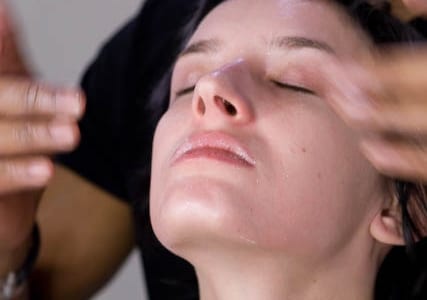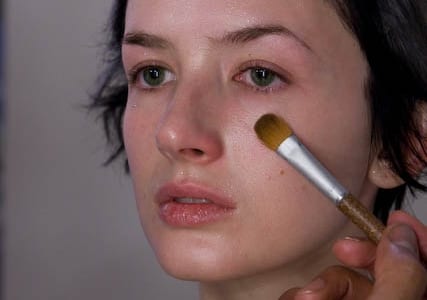Want to have a clear, luminous complexion? Learn the tricks of the trade with these makeup artist tips from NYC-based Rudy M...
As a makeup artist, having the technical ability to create a balance, even complexion is a must. Skin is the “foundation” fundamental for every makeup look that is created. Here are some easy tips to practice and perfect so that you can master beautiful skin every time.
1. Preparation
 Remember that beautiful makeup begins with beautiful skin; makeup is an accessory that enhances whatever is underneath it. Proper home maintenance skincare is essential, but we don’t always know if our client is taking proper care of their skin. For this reason, we must prepare the skin to guarantee an even, smooth application.
Remember that beautiful makeup begins with beautiful skin; makeup is an accessory that enhances whatever is underneath it. Proper home maintenance skincare is essential, but we don’t always know if our client is taking proper care of their skin. For this reason, we must prepare the skin to guarantee an even, smooth application.
– Always begin with clean skin. Remove any eye makeup first with eye makeup remover. Remove all product from the upper lid, then the lower lash line. Be gentle in the delicate eye area.
– Though makeup wipes are effective, choose aroma free when possible. One of the main sensitivities that you will encounter is to highly perfumed or fragranced products. A gentle face cleanser can also be used and removed using a face wipe dampened with water.
– Toner is often omitted from skincare regimens, but is an essential step.Choose an alcohol-free toner to rehydrate and balance the freshly cleansed skin. Keep in mind that cleansing strips away not only dirt and debris but also essential natural oils.
– Apply eye creme high onto the cheekbones (orbital bone). Eye cremes are formulated specifically for the thin, delicate under-eye area whereas facial moisturizers are formulated for the rest of the face.
– Hydrate the skin. You will need both a lightweight, possibly oil-free moisturizer for oily to combination skin type and a more emollient moisturizer for normal to dry skin. SPF 15 or above is still recommended, even though many of the foundation products on the market today provide SPF protection as well. Keep in mind that SPF moisturizers may need five minutes to fully absorb into the skin before foundation application.
2. Foundation

Makeup should be customized for each face you work on; no one has the same eye shape, skin type/tone, or lifestyle. For that reason, choose the foundation that is best for the needs of the skin you are working on.
The market is booming today with every option of coverage, treatment, and finish. To simplify your options, think of these two things:
– Coverage: how much the product camouflages imperfections. If the skin is well cared for and needs minimal corrective work, sheer foundations like tinted moisturizers, BB and CC cremes, and the like are perfect to use. If there are obvious imperfection and challenges, you may choose the benefits of a liquid foundation or stick foundation.
– Finish: how the product looks and feels on the skin. Just as you choose the proper moisturizer for the skin, the finish of the foundation product is equally important. Dry skin needs hydration and luminosity, so the dewy and semi-matte finishes of tinted moisturizers, BB and CC cremes, and some stick foundations maintain a skin-like appearance when applied. People with oily skin tend to prefer shine and products to help control and minimize oiliness, so creme-to-powder and powder foundations are effective choices.
3. Application

The goal when applying foundation products is to improve upon the natural tone and texture of the skin. For this reason, the product should not sit on the surface of the face or look obviously thick and cakey.
Test for a color match where the most coverage is needed; for many this would be the rosy cheek areas and sometime the lighter interior of the face. Testing along the jawline is popular, too, but this is where you want the foundation to disappear to avoid the mask effect. Therefore, when you apply the product where needed most, you will have a sheer finish after blending to where the product is needed least.
Here are some additional tips:
– It helps to apply liquid and creme foundations products before concealer. This technique provides an emollient surface for the concealer to blend and helps minimize the amount of concealer used; this is because the foundation product begins to build coverage, therefore balancing the skin. Use a dampened sponge or a synthetic fiber brush to buff the foundation seamlessly into the skin. For powder foundation products, you will need to apply the concealer first and use the powder foundation to set the concealer and build your complexion look/finish.
– Because concealer is a full-coverage product, you will use it minimally to get the results you want. Start with very little product and add more if needed. For blemishes and spot-treating areas, use fine-tipped synthetic fiber brushes to dab on concealer. For longevity and to prevent creasing, apply a small amount of powder over concealer application.
– Powder can be used where needed to minimize excess shine. If you are excessively powdering the entire face, perhaps a powder foundation is a better product choice.
As makeup artists, we must study intensely or with intense intent. The fundamentals of makeup artistry are often lost in the illusion and glamour of our industry. I love offering my makeup artist tips to artists in training and women who want their makeup to look artist professional. Join me in a private lesson to transform your makeup application.
 Rudy M. is an editorial makeup artist, licensed skin care therapist, and educator in New York, NY. His specialties include beauty, bridal, airbrush, runway, and editorial styles. Learn more about Rudy here!
Rudy M. is an editorial makeup artist, licensed skin care therapist, and educator in New York, NY. His specialties include beauty, bridal, airbrush, runway, and editorial styles. Learn more about Rudy here!
Suzy S.

